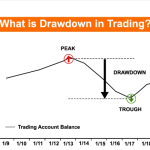
The Dow Jones Industrial Average (DJIA): An Overview
The Dow Jones Industrial Average (DJIA) is one of the most well-known and widely recognized stock market indices in the world. It represents the overall health and performance of the U.S. economy by tracking 30 large, publicly traded companies across various industries. Founded in 1896 by Charles Dow and Edward Jones, it initially included just 12 companies, primarily from the industrial sector. Today, while it still retains the name “industrial,” the DJIA covers a more diverse range of industries, reflecting the modern economy’s evolution beyond traditional manufacturing and heavy industry.
What is the DJIA?
The DJIA is a price-weighted index, which means that companies with higher stock prices have a more significant influence on the index’s movements than those with lower prices, regardless of the company’s actual size or market capitalization. The 30 companies included in the index are considered blue-chip stocks—large, stable companies with a history of steady earnings and dividends. The components of the DJIA are periodically updated to ensure that it remains reflective of the broader economy, often replacing companies that may no longer be as relevant or influential.
The Dow is calculated by adding the stock prices of the 30 companies and then dividing by a divisor (which adjusts for stock splits, dividends, and other corporate actions). The divisor ensures that these actions do not artificially affect the index’s level. See Dow Jones Theory and how its related to DJIA.
Why is the DJIA Important for Investors?
- Barometer of Economic Health: The DJIA serves as a key indicator of the general market and economic trends. When the DJIA rises, it usually signals confidence in the economy, as investors feel positive about corporate earnings and future growth. Conversely, when the DJIA falls, it often indicates concerns about economic stability or potential slowdowns.
- Historical Significance: The Dow is one of the oldest stock indices, providing a century’s worth of historical data. Investors and analysts use the long-term performance of the DJIA to assess market cycles, economic growth, and financial crises, offering perspective for long-term investment strategies.
- Investor Sentiment: Because of its visibility in the media, the DJIA is often used as a shorthand for the stock market’s overall performance. Headlines about “The Dow” rising or falling can influence investor sentiment, especially among retail investors who may not follow other broader or more complex indices like the S&P 500 or Nasdaq.
- Diversification in Key Sectors: Though the DJIA only tracks 30 stocks, these stocks are from a variety of sectors, including technology, finance, healthcare, and consumer goods. This makes it a useful benchmark for investors who want exposure to different parts of the U.S. economy without diving deep into individual sectors.
- Benchmark for Investments: Many mutual funds, ETFs, and other financial products are benchmarked against the DJIA, making it an essential measure for portfolio performance. If an investment outperforms the DJIA, it’s often considered successful; if it underperforms, investors might look elsewhere.
Current Stocks in the DJIA
As of 2024, the 30 companies in the DJIA are some of the most influential in the global economy. These companies span various industries:
- Technology: Apple (AAPL), Microsoft (MSFT), Intel (INTC), Cisco Systems (CSCO), Salesforce (CRM)
- Healthcare: UnitedHealth Group (UNH), Johnson & Johnson (JNJ), Amgen (AMGN)
- Finance: Goldman Sachs (GS), JPMorgan Chase (JPM), Visa (V), American Express (AXP)
- Consumer Goods: Coca-Cola (KO), Procter & Gamble (PG), Walmart (WMT), Nike (NKE), McDonald’s (MCD)
- Industrials: Boeing (BA), Caterpillar (CAT), Honeywell (HON)
- Energy: Chevron (CVX)
- Communication: Verizon (VZ), Disney (DIS)
These companies represent a cross-section of industries, ensuring that the index reflects a broad spectrum of the U.S. economy. Changes in technology stocks like Apple or Microsoft may signal shifts in the tech sector, while movements in JPMorgan or Goldman Sachs reflect trends in the financial sector.
How the DJIA Reacts to Economic Events
The DJIA is highly sensitive to both macroeconomic news and company-specific developments. Key economic indicators, such as interest rate changes, inflation reports, and unemployment data, can cause significant volatility in the index. For example, if the Federal Reserve raises interest rates to combat inflation, it may hurt sectors that are sensitive to borrowing costs, such as housing and financial services, leading to a potential decline in the DJIA.
Conversely, positive news—such as corporate earnings beating expectations, or government stimulus packages—often leads to a surge in the Dow. Global events, such as trade wars or geopolitical conflicts, can also impact the DJIA, especially for companies with large international operations.
Limitations of the DJIA
Despite its prominence, the DJIA has several limitations:
- Price-Weighted Nature: Since the index is price-weighted, higher-priced stocks (e.g., Apple and UnitedHealth) have a disproportionate impact on the index’s movement, regardless of the actual size of the company. This can give a skewed impression of the market’s performance.
- Limited Number of Stocks: The DJIA includes only 30 companies, while broader indices like the S&P 500 track a much wider range of companies, offering a more comprehensive view of the stock market.
- Exclusion of Small and Mid-Cap Stocks: The Dow primarily consists of large, established companies, excluding smaller or mid-sized firms that may be experiencing rapid growth. This makes it less suitable for tracking trends in smaller, emerging sectors of the economy.
- Sector Concentration: While the DJIA does cover multiple sectors, its concentration in certain industries (such as technology and finance) may cause it to underrepresent other parts of the economy, such as energy or real estate.
Investing in the DJIA
Investing in the Dow Jones Industrial Average (DJIA) offers a straightforward way for investors to gain exposure to some of the largest and most stable companies in the U.S. economy. Since it consists of 30 blue-chip stocks from diverse sectors, the DJIA is a valuable indicator of the broader market’s health. Many of the companies in the index, such as Apple, Johnson & Johnson, and JPMorgan Chase, are leaders in their respective industries, making the index appealing to investors seeking long-term stability and steady growth.
One of the key benefits of investing in the DJIA is diversification. Although the index tracks only 30 companies, those companies represent a wide range of sectors, including technology, healthcare, finance, consumer goods, and industrials. This sector diversification helps spread risk, as declines in one industry (e.g., energy) may be offset by gains in another (e.g., technology). For investors looking to simplify their portfolios, investing in an exchange-traded fund (ETF) that tracks the DJIA, such as the SPDR Dow Jones Industrial Average ETF (DIA), can provide broad exposure without needing to buy individual stocks.
Another advantage is the relative stability of the DJIA components. The companies included in the index are typically large, financially secure, and have a history of consistent earnings. This makes the DJIA less volatile than indices that include more speculative or smaller companies. For conservative investors, the DJIA is often viewed as a safer option for preserving capital while still participating in the growth of the stock market. In addition, many of the stocks in the index pay dividends, offering regular income alongside the potential for price appreciation.
However, there are some considerations investors should keep in mind. Because the DJIA is price-weighted, higher-priced stocks have a greater influence on the index’s movement. This can lead to disproportionate swings based on just a few companies, making it important for investors to understand the weighting of the individual stocks in the index. Moreover, while the DJIA offers sector diversification, it includes only large-cap companies, meaning it does not provide exposure to smaller, fast-growing companies that may offer higher returns over time.
Overall, investing in the DJIA can be a solid strategy for those looking to invest in established companies with proven track records. It’s ideal for long-term investors who want to participate in the broader market’s growth while minimizing exposure to smaller, riskier stocks. By incorporating DJIA-focused ETFs or mutual funds into their portfolios, investors can enjoy the benefits of diversification, stability, and the potential for steady returns. However, as with any investment, it’s important to consider personal risk tolerance and financial goals when deciding how much to allocate to the DJIA.
Conclusion
The Dow Jones Industrial Average remains a crucial gauge for both professional and retail investors alike. Its long history, role as a barometer for economic performance, and inclusion of blue-chip stocks make it an essential tool for anyone interested in understanding the health of the U.S. stock market. While it has its limitations, the DJIA’s ability to influence sentiment and serve as a benchmark ensures its ongoing importance in global financial markets. Investors often keep a close eye on the DJIA as a quick snapshot of economic momentum, even as they consider broader or more comprehensive indices for more detailed analysis.







